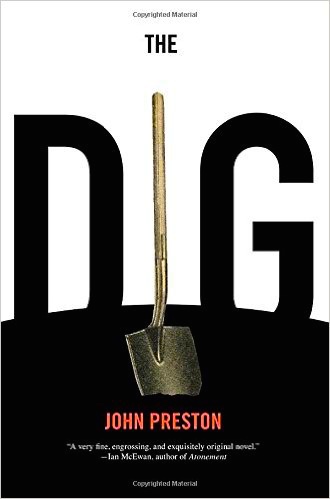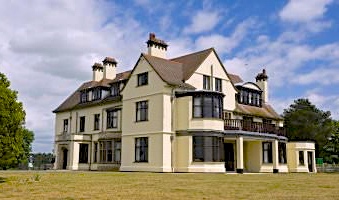“On the outside, I was perfectly controlled….My mind, though, was a riot. Dazzled one moment, then plunged into confusion the next. But even in the midst of this headspin, I knew with absolute certainty that I would unearth something… All the time my hands worked unhesitatingly away, just as if they were being guided. They might have had strings attached to them.”—Peggy Piggott, archaeologist at Sutton Hoo.
 Both a journalist and a novelist, British author John Prescott puts all his writing talents to use in this stimulating work which straddles the line between reality and fiction. Set in June, 1939, near Woodbridge, on a North Sea estuary about a hundred miles northeast of London, The Dig engages the reader from the opening Prologue. Basil Browne, a local resident with great sensitivity to the both geology and archaeology, has returned at night to the site where he has been digging for several weeks and where he has already found evidence of a ship, its outline preserved by elements from the local soil which have replaced the material from which the ship was originally constructed. No longer digging but carefully brushing away dirt with a pastry brush to avoid causing any damage, Browne has now unearthed a piece of ancient wood, which he believes may be part of a burial chamber inside the ship and which may date back to the Vikings. Browne has been leading a few local workers hired by Mrs. Edith Pretty, the widowed owner of an estate called Sutton Hoo, to excavate some of the strange mounds which dot her agricultural land. Her deceased husband had always wondered what was inside these mounds – almost two dozen of them – and as they seem to have been remote enough to have escaped the depredations of looters who have ruined other sites, Mrs. Pretty now hopes to honor his memory by unearthing something of historical importance. When Browne, in his excitement, rushes back to the estate to tell Mrs. Pretty what he has just discovered, he is put in his place by the butler; Mrs. Pretty is preparing for bed and the butler will not disturb her.
Both a journalist and a novelist, British author John Prescott puts all his writing talents to use in this stimulating work which straddles the line between reality and fiction. Set in June, 1939, near Woodbridge, on a North Sea estuary about a hundred miles northeast of London, The Dig engages the reader from the opening Prologue. Basil Browne, a local resident with great sensitivity to the both geology and archaeology, has returned at night to the site where he has been digging for several weeks and where he has already found evidence of a ship, its outline preserved by elements from the local soil which have replaced the material from which the ship was originally constructed. No longer digging but carefully brushing away dirt with a pastry brush to avoid causing any damage, Browne has now unearthed a piece of ancient wood, which he believes may be part of a burial chamber inside the ship and which may date back to the Vikings. Browne has been leading a few local workers hired by Mrs. Edith Pretty, the widowed owner of an estate called Sutton Hoo, to excavate some of the strange mounds which dot her agricultural land. Her deceased husband had always wondered what was inside these mounds – almost two dozen of them – and as they seem to have been remote enough to have escaped the depredations of looters who have ruined other sites, Mrs. Pretty now hopes to honor his memory by unearthing something of historical importance. When Browne, in his excitement, rushes back to the estate to tell Mrs. Pretty what he has just discovered, he is put in his place by the butler; Mrs. Pretty is preparing for bed and the butler will not disturb her.
This Prologue sets the scene, the tone, and the atmosphere for the narrative which follows. Sutton Hoo is a real place, and its excavations, along with the internecine rivalries which emerge among local and national historic preservation groups, as they are described here, parallel what really happened in 1939, bringing the author’s journalistic skills to the forefront. The novel really excels, however, in the vibrant personalities created for Basil Browne, Grately the butler, Mrs. Pretty, and all the other participants in the drama of the excavation. These emerge through the characters’ conversations and behavior, which though plausible under the circumstances, are not factual (unless someone has left long personal recordings that have never been discovered). Adding dialogue and some imagination to his reality allows author Preston much more flexibility in telling his story, however. His characters become much “rounder” and more realistic, allowing modern readers to identify with them and be drawn into the expanded story.

Sutton Hoo, near Woodbridge, about a hundred miles northeast of London, on an estuary a few miles from the North Sea.
Three main points of view carry the narrative, beginning with the brief Prologue by Basil Browne, the local man consumed with his mission to find and preserve the artifacts he believes are hidden in the mounds, then changing to that of Edith Pretty a widow who seems much older than she is. Married when she was in her mid-thirties to a man fifteen years older, Mrs. Pretty was in her late forties, and her husband Frank in his early sixties, when she gave birth to their son Robert. Because her husband, was always interested in the mounds on their farm in Sutton Hoo, Mrs. Pretty decides to have one or more of them excavated as a memorial to him after his death. The impending outbreak of World War II hastens her decision, and much of the excavation is pushed along because of fear that with war, all work will have to stop. Because Mrs. Pretty is physically weak and sickly, and sometimes suffers from vertigo, her son Robert, a bright, young boy with nothing to do and no one to play with, spends much time “helping” on the dig, which provides him with attention he does not get at home.
The discovery of a “ghost” ship (so-called because the wood that it was made from has all rotted away, leaving only an outline in the sand) can not be kept secret from local residents, and Mrs. Pretty’s decision to have a sherry party and tour of the site for local historians unmasks the resentments and jealousies among them, which spread as the news travels to the wider world. Rivalries among competing local historical museums, Cambridge University, and the British Museum itself become intense, as each groups wants a piece of the action, not to mention the artifacts themselves. One group even seeks funding to build a special museum locally so that all the discoveries can stay local. As it gradually becomes apparent that Sutton Hoo may be a more significant archaeological site than originally assumed, national officials eventually exercise their powers over the locals and engineer their replacement or demotions as managers of the site.

Screen capture of the ghost image of the ship from a film of the work by Harold John Phillips. Note that the interior of the ship is of sand which replaced the original wood as it decayed. Click to enlarge.
One of the new professionals hired at the site is Peggy Piggott, a newlywed on her honeymoon, who with her husband sees this as a fascinating opportunity to start a new life and career. Peggy knows what she is doing at the dig, though how far she can trust her husband is open to question. She becomes the third point of view here and further adds to the story by having her nephew, a photographer, come to stay and take photographs of the work site. Edith Pretty and Basil Brown bring their points of view up to date again in later sections, as the courts decide who actually owns the treasure. In a wonderful coda to the novel, Robert Pretty, Edith’s son, returns to the site in 1965, more than twenty-five years later, and shares his memories and discoveries upon his arrival there, providing a firm closing to the novel.

Helmet found at Sutton Hoo, thought to have belonged to Raedwald (599 – 624), King of the East Anglians.
However exotic the subject matter, the author’s style remains plain and unadorned. He eschews fancy terminology and provides little in the way of complex analysis of the artifacts to prove their age and purpose. When he says that most professionals now regard the burial site at Sutton Hoo to be that of the early East Anglian King Raedewald (599 – 624), and not a later Viking king, the reader sees his rationale and accepts it at face value. The site’s “treasures,” primarily belts, shoulder clasps, armor, pottery, and some gold and jewel work provide proof, should anyone need it, that the Dark Ages were certainly not dark in East Anglia. On my Favorites list, this absorbing and well written book about an historic find will satisfy and entertain book clubs, adult readers, and Young Adults curious about ancient history.
ALSO by John Preston, A VERY ENGLISH SCANDAL: Sex, Lies, and a Murder Plot at the Heart of the Establishment
Photos, in order: The author’s photo by Toby Jenkins appears on http://www.goodreads.com/
Tranmer Hall, formerly known as Sutton Hoo House, is part of the National Trust for Historic Preservation. http://www.nationaltrust.org.uk/sutton-hoo
Mound #1 at Sutton Hoo, photo by John Robertson. http://www.telegraph.co.uk/
Screen capture of the ghost image of the ship, from a film of the work by Harold John Phillips. Note that the interior of the ship is now sand which replaced the original wood as it decayed. Click to enlarge. https://en.wikipedia.org/
Helmet found at Sutton Hoo, thought to have belonged to Raedwald (599 – 624), King of the East Anglians. https://commons.wikimedia.org/
ARC: Other Press


